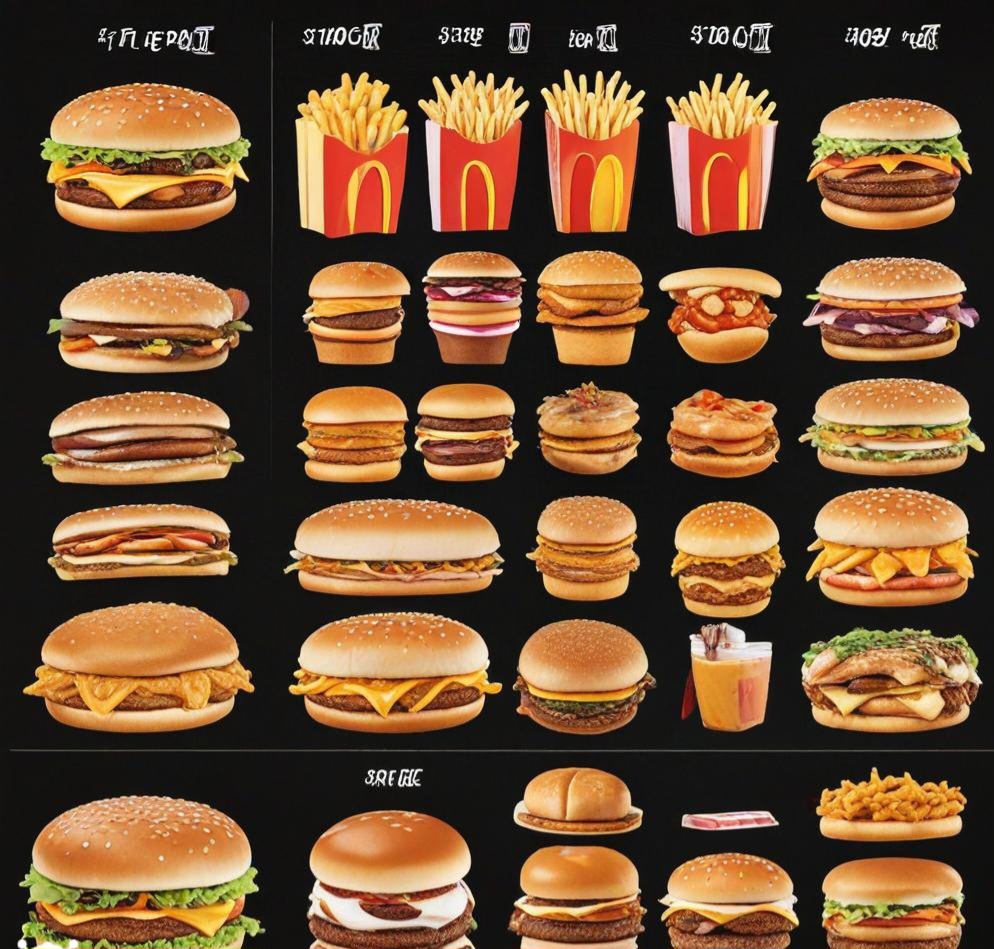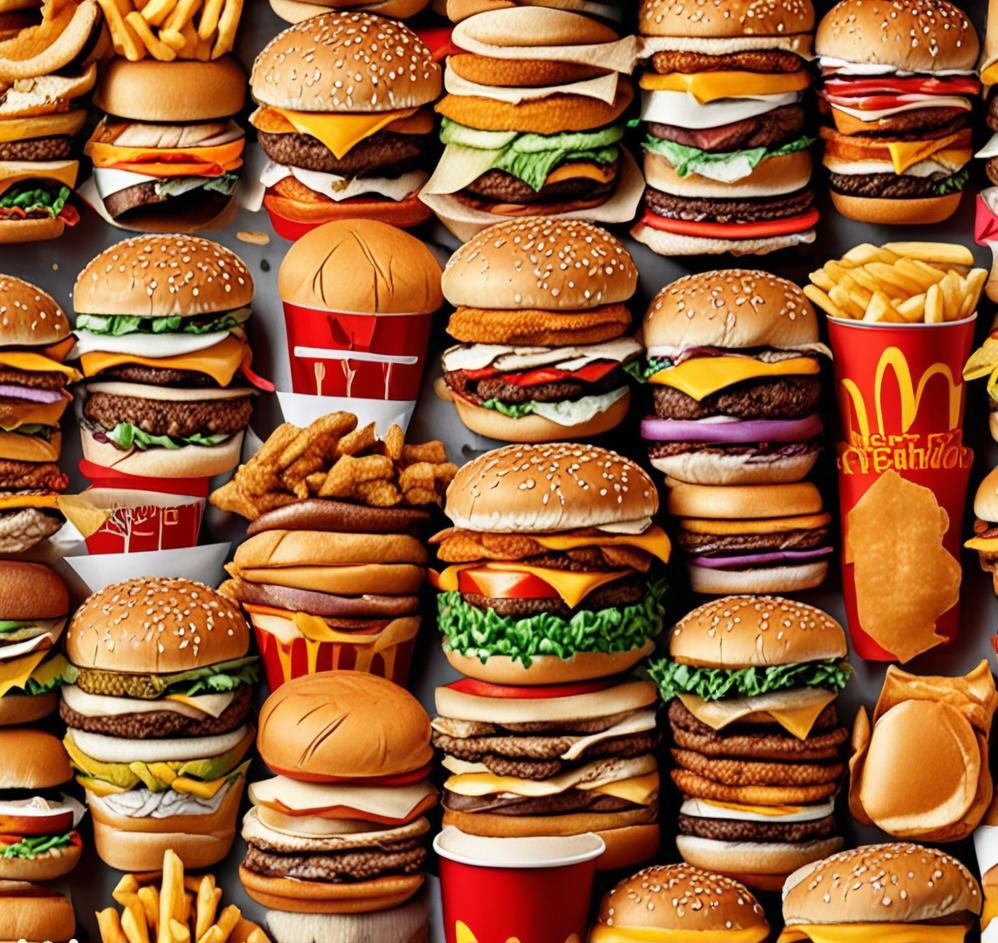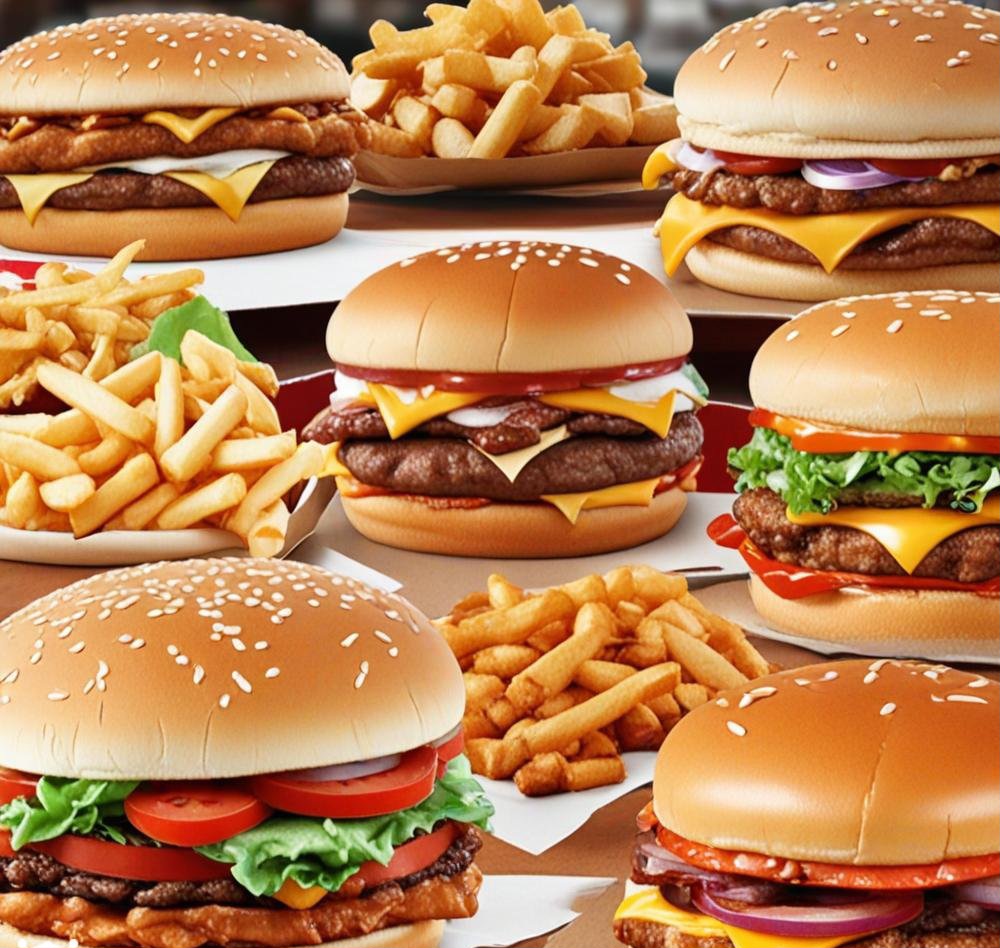Comparing Fast Food Menu Items: Which Chains Offer the Best Value?”
Introduction
Overview of the Fast Food Industry

The fast food industry stands as an emblem of modern consumer culture—its essence encapsulated in three defining traits: speed, convenience, and affordability. With an expansive array of menu offerings tailored to suit diverse palates and dietary preferences, fast food chains continue to thrive despite the growing societal shift toward health-conscious consumption. In fact, recent market analyses reveal that the global fast food sector, valued at several hundred billion dollars, is poised for sustained expansion. This relentless growth is fueled by an ever-accelerating pace of life, where quick, accessible meals have become an indispensable part of daily routines.
Popularity and Growth Trends
Fast food’s metamorphosis over the decades is nothing short of remarkable. What once revolved around quintessential burger-and-fries establishments has evolved into an intricate network of culinary diversity, spanning gourmet-style offerings, plant-based innovations, and culturally adapted menus that resonate with regional tastes. Giants like McDonald’s, Burger King, and Taco Bell have long mastered the art of blending global branding with localized flavors, ensuring their foothold in an increasingly competitive marketplace.
Moreover, technological advancements are reshaping the landscape of fast food consumption. The proliferation of mobile apps, self-service kiosks, and AI-driven order personalization has streamlined customer interactions, minimizing wait times while maximizing efficiency. Delivery services, bolstered by third-party platforms such as Uber Eats and DoorDash, have further extended the industry’s reach, reinforcing the notion that convenience remains king.
Consumer Demand for Value
In an era where economic fluctuations dictate spending behaviors, consumers have become increasingly judicious about their food expenditures. The modern fast food patron isn’t merely seeking sustenance but is also weighing the perceived worth of their meal—assessing factors such as taste, portion size, ingredient quality, and pricing. This heightened scrutiny has compelled fast food chains to recalibrate their approach, introducing budget-friendly meal deals, promotional discounts, and loyalty rewards to entice cost-conscious customers.
Value in fast food transcends mere affordability; it is a composite measure of satisfaction, encompassing both the tangible and intangible elements of the dining experience. A well-portioned, flavorful burger at a competitive price point may appeal just as much as a premium offering with organic ingredients—each catering to distinct consumer expectations. The delicate equilibrium between cost-effectiveness and quality dictates purchasing decisions, making value perception a pivotal battleground in the industry.
Factors Determining Value in Fast Food
Price vs. Quality
The eternal tug-of-war between price and quality remains a defining factor in the fast food industry. Consumers weigh affordability against the sensory and nutritional experience a meal provides. While some prioritize budget-friendly bites, others scrutinize the quality of ingredients, their sourcing, and the overall craftsmanship behind each dish. Fast food chains, keenly aware of these divergent expectations, continually refine their strategies to strike a delicate balance between cost efficiency and consumer satisfaction.
Ingredient Sourcing
The provenance of ingredients has evolved into a significant differentiator among fast food brands. Some chains lean into hyper-processed, mass-produced elements to maintain affordability, while others embrace a more transparent, ethically conscious approach. Locally sourced produce, organic meats, and non-GMO staples are no longer niche— they’re fast becoming mainstream demands. Establishments that champion superior sourcing not only attract health-conscious patrons but also cultivate long-term brand loyalty, solidifying their reputation as premium fast food providers.
Portion Sizes
Size matters—at least in the realm of fast food. Generous portions create a perception of enhanced value, reinforcing consumer satisfaction. Conversely, skimpy servings can trigger discontent, making diners feel shortchanged. However, the equation isn’t that simple. As public discourse around obesity and portion control intensifies, chains must navigate a tricky middle ground: delivering filling yet nutritionally balanced meals. The challenge? Satisfying appetites while maintaining a responsible stance on health and wellness.
Nutritional Value
With health consciousness on an upward trajectory, fast food is no longer merely about indulgence—it’s about informed choices. Modern consumers demand transparency, scrutinizing nutritional labels, ingredient lists, and calorie counts before making a purchase. This shifting landscape forces fast food establishments to innovate, ensuring that “quick and cheap” doesn’t equate to “unhealthy and unsatisfying.”
Healthy Options Available
No longer confined to the realm of salads and low-calorie wraps, “healthy fast food” is expanding. Grilled proteins, plant-based alternatives, and nutrient-rich add-ons are infiltrating menus, catering to a generation that values both speed and sustenance. For many brands, the key to staying relevant lies in seamlessly integrating these options without alienating their core customer base—balancing indulgence with nutrition in a way that feels both effortless and appealing.
Caloric Content Transparency
A meal’s calorie count can be a deal-breaker for today’s informed diner. With rising concerns over obesity and lifestyle diseases, transparency in nutritional labeling has become a competitive advantage. Chains that prominently display caloric information, alongside offering viable lower-calorie alternatives, position themselves as forward-thinking and consumer-conscious. Whether it’s through portion control, ingredient swaps, or innovative cooking methods, restaurants that take caloric transparency seriously tend to foster greater trust and customer retention.
Promotions and Deals
In an industry where competition is ruthless, strategic pricing and promotional offers act as powerful levers to attract and retain customers. Value isn’t just about the food itself—it’s about the perception of getting more for less. Discounts, combo meals, and loyalty perks significantly impact consumer behavior, making affordability a cornerstone of the fast food experience.
Value Meals
Bundling items into value meals isn’t just a tactic—it’s a psychological nudge. Customers love the illusion of savings, and combo deals serve as an irresistible hook. Limited-time promotions, seasonal offerings, and strategically priced meal bundles not only drive sales but also enhance perceived value, making diners feel like they’re scoring a deal rather than simply purchasing a meal.
Loyalty Programs
In a landscape where brand allegiance is fickle, loyalty programs function as silent yet potent motivators. Reward points, exclusive discounts, and tier-based perks encourage repeat visits, subtly embedding a sense of commitment within consumers. The brands that master this game don’t just create one-time customers—they cultivate long-term brand advocates who keep coming back for more.
The fast food industry thrives on a complex interplay of price, quality, nutrition, and strategic marketing. The modern consumer, more informed than ever, evaluates meals not just for taste but for their overall value proposition—balancing affordability with health consciousness, indulgence with practicality. In this ever-evolving landscape, chains that can adapt swiftly and innovate intelligently will continue to dominate, shaping the future of fast food dining.
Would you like any refinements or adjustments to further align with your vision?
Comparison of Fast Food Chains

The fast food industry thrives on a delicate balance of cost, convenience, and consumer perception. While some chains lean heavily into affordability, others emphasize ingredient quality, customization, or unique culinary twists. The result? A competitive landscape where value isn’t just about price—it’s about what the customer gets in return. Let’s break down how leading fast food giants position themselves in this ongoing battle for consumer loyalty.
McDonald’s: The Global Giant
McDonald’s is more than just a fast-food chain; it’s a cultural phenomenon. Recognizable across continents, the brand has mastered the art of consistency, affordability, and strategic marketing.
Signature Menu Items
Few menu items are as globally iconic as the Big Mac. The same can be said for McNuggets, which have retained their popularity through decades of evolving food trends. These staples serve as cornerstones of the McDonald’s brand, reinforcing the idea that familiarity breeds loyalty. While innovation is necessary, the strength of McDonald’s lies in its ability to keep classics relevant.
Value Menu Options
For the budget-conscious, McDonald’s Value Menu is a haven of affordability. Items like the McDouble and small fries provide an accessible entry point for diners looking to maximize savings. Limited-time promotions—such as the ever-popular “Mix and Match” deals—add an element of excitement while subtly encouraging larger purchases. The strategy? Offer just enough variety to keep customers engaged without overwhelming them with choices.
Burger King: The Flame-Grilled Challenger
Burger King positions itself as the bolder, flame-kissed alternative to its competitors. With aggressive pricing strategies and frequent promotional pushes, it remains a strong contender in the value-driven market.
Whopper Pricing and Promotions
The Whopper isn’t just a burger; it’s a statement. Priced strategically to compete with other flagship sandwiches, it’s often at the center of Burger King’s promotional playbook. Buy-One-Get-One (BOGO) deals, meal bundles, and limited-time discounts transform the Whopper from a simple burger into a compelling value proposition.
Value Meals and Bundles
To further solidify its standing, Burger King crafts meal deals that cater to families and solo diners alike. The King Deals lineup, featuring mix-and-match discounts, creates an appealing sense of customization—because in fast food, choice matters just as much as price.
Wendy’s: The Freshness Advocate
Wendy’s differentiates itself with a firm stance on ingredient quality. Its “fresh, never frozen” beef slogan isn’t just marketing fluff—it’s a key pillar of its brand identity.
Fresh Ingredient Philosophy
Where others prioritize affordability, Wendy’s leans into quality. This emphasis on fresh ingredients resonates with customers who perceive fast food as synonymous with compromise. While the price point may be slightly higher, the psychological trade-off—quality over cost—justifies the expense for many diners.
Value Menu Highlights
But Wendy’s doesn’t ignore budget-conscious customers. The 4 for $4 deal, a staple in its value lineup, provides an attractive combination of variety and affordability. Unlike rigid meal bundles, this offering allows for a level of customization, reinforcing the idea that value isn’t just about price—it’s about control.
Taco Bell: The Innovator of Affordable Flavor
Taco Bell carves its niche through bold flavors and creative menu offerings. Unlike burger-centric chains, it taps into Mexican-inspired fare to set itself apart.
Taco Value Options
The Value Menu is a cornerstone of Taco Bell’s affordability strategy. Crunchy Tacos, Cheesy Fiesta Potatoes, and $1 menu items appeal to students, late-night snackers, and budget-conscious diners alike. The key here isn’t just price—it’s how much flavor and satisfaction can be packed into a low-cost meal.
New Menu Innovations
Where Taco Bell truly excels is in reinvention. The Doritos Locos Tacos was a game-changer, blending brand collaboration with novelty. More recently, the introduction of plant-based options has expanded its reach, attracting health-conscious and vegetarian consumers without alienating its core audience.
Subway: Customization and Health-Conscious Dining
In an industry driven by speed and uniformity, Subway takes a different approach—empowering customers with control over their meals.
Customization and Pricing
The ability to build a sandwich from scratch offers a level of personalization rarely seen in fast food. This makes Subway an appealing choice for those with dietary restrictions or specific taste preferences. However, this customization also means that pricing fluctuates based on choices—giving customers control over both their meal and their budget.
Healthier Fast Food Choice
Unlike its competitors, Subway leans heavily into the “Eat Fresh” narrative. With an array of fresh vegetables, lean proteins, and lower-calorie bread options, it markets itself as a healthier alternative to traditional fast food. This positioning allows it to attract a distinct consumer base—one that values nutrition as much as convenience.
–
Final Thoughts: Value Beyond Price
While price remains a major driver of consumer choice, fast food chains must navigate an increasingly complex landscape where value is defined by more than just cost. Ingredient quality, customization, portion sizes, and promotional deals all play crucial roles in shaping consumer perceptions.
For some, value is found in a cheap and filling meal. For others, it’s about premium ingredients and better sourcing. And for an emerging segment of consumers, it’s about health-conscious options without sacrificing flavor.
Fast food chains that recognize these shifting priorities—and adapt accordingly—will continue to thrive. Those that don’t? Well, history isn’t always kind to the slow movers in this industry.
Consumer Perceptions of Value in Fast Food

Value in the fast food industry is far from a static concept—it’s a constantly shifting perception shaped by consumer experiences, market trends, and digital influence. While affordability remains a driving force, modern diners weigh additional factors such as quality, service, and even brand engagement. Let’s dive into the intricate web of elements that dictate how consumers perceive value in fast food.
Customer Reviews and Ratings: The Digital Word-of-Mouth Effect
The opinions of past diners wield tremendous power in the fast food industry. In an era where a single review can sway public perception, consumers often look to digital platforms for guidance before making dining decisions.
Online Feedback & Surveys
The internet has revolutionized the way consumers evaluate fast food. Review sites such as Yelp, Google Reviews, and dedicated food blogs have become digital battlegrounds where brands either thrive or falter. Aggregated customer ratings serve as real-time report cards, offering insights into everything from food quality to service efficiency.
Additionally, large-scale market research surveys shed light on emerging consumer preferences. These surveys don’t just highlight the best-selling menu items—they uncover shifting trends in dining habits, such as the growing demand for plant-based options or skepticism toward artificial ingredients. Chains that earn high marks in these assessments reinforce their reputation as providers of consistent, reliable value, fostering long-term loyalty.
The Social Media Factor: Visibility Equals Value
In today’s fast-paced digital ecosystem, fast food brands that harness social media wield an undeniable advantage. Platforms like Instagram, Twitter, and TikTok have transformed the way consumers engage with their favorite brands.
But it’s not just official marketing campaigns driving engagement—user-generated content plays an equally significant role. A viral food hack, a stunning image of a double-stacked burger, or an influencer raving about a limited-time promotion can catapult an item into the public consciousness. Suddenly, a menu item that was previously overlooked is now the hottest trend—not because of a price change, but because its perceived value skyrocketed through social proof.
Brands that respond to feedback, engage in humorous banter, or even address customer complaints publicly can shape perceptions in real time. In an age where online reputation is often as important as in-store experience, social media influence can amplify or erode a brand’s value proposition within moments.
Market Studies and Reports: The Science Behind Value Perception
Beyond individual reviews, broader industry studies provide crucial insights into the economic and psychological factors that define value in fast food.
Value Rankings by Analysts: The Scoreboard Effect
Each year, industry analysts compile rankings of fast food chains based on metrics like price competitiveness, portion sizes, customer satisfaction, and menu innovation. These rankings act as unofficial scoreboards, helping consumers identify which brands consistently offer the best return on their dining dollars.
A high ranking on these lists can serve as a credibility booster, making a chain the go-to choice for value-seekers. Conversely, a poor ranking—especially when widely reported—can signal declining consumer trust and trigger a reputational crisis. For this reason, fast food chains meticulously track these rankings, adjusting strategies to maintain favorable standing.
Industry Comparisons: The Battle for Perceived Worth
Beyond rankings, comparative market studies offer deeper insights into how different chains stack up against each other. These reports analyze factors like:
Pricing strategies: Which brands offer the most competitive pricing while maintaining quality?
Menu diversity: How do brands balance affordability with dietary variety?
Consumer trends: Are health-conscious options increasing in value perception?
These insights don’t just benefit analysts—they shape consumer behavior. A widely shared report emphasizing one chain’s superior deals or another’s focus on organic ingredients can directly influence purchasing decisions.
Final Thoughts: Value Is More Than Just a Price Tag
In a world where a $5 meal can either be seen as a steal or a ripoff, consumer perceptions of value go far beyond simple cost analysis. The modern fast food landscape demands a multifaceted approach to value, blending affordability, quality, service, branding, and digital influence into one cohesive experience.
For some, value is synonymous with cheap and filling meals.
For others, it’s about ingredient integrity and ethical sourcing.
And for an increasing number of consumers, it’s tied to brand engagement and digital reputation.
Fast food chains that understand and adapt to these evolving expectations will continue to thrive. Those that fail to recognize the nuances of consumer perception? They risk fading into irrelevance, lost in a sea of brands that truly understand the modern diner’s mindset.
Conclusion: The Evolving Definition of Value in Fast Food

Summary of Findings: A Shifting Consumer Mindset
In dissecting the intricate landscape of fast food, one reality becomes apparent: value is no longer a static equation of cost versus quantity. Instead, it has evolved into a multifaceted concept—one that intertwines affordability with quality, convenience with ethics, and indulgence with nutrition.
Throughout this analysis, we uncovered the nuanced factors influencing perceived value, from ingredient transparency and portion sizes to nutritional considerations and promotional strategies. No single chain dominates across all dimensions; rather, each brand cultivates a niche tailored to specific consumer preferences.
Best Value Chains: Who Rises to the Top?
Distilling the findings, a few standout brands emerge as leaders in delivering exceptional perceived value:
Wendy’s maintains a stronghold with its fresh, never frozen beef, appealing to consumers who prize ingredient integrity.
Taco Bell capitalizes on affordability and innovation, offering unique flavor combinations at budget-friendly prices.
McDonald’s continues to dominate with an expansive value menu, ensuring accessibility for cost-conscious diners.
Burger King sustains its competitive edge through aggressive BOGO promotions and loyalty incentives.
Subway remains the health-conscious alternative, leveraging customization and fresh ingredients to appeal to an evolving demographic.
Yet, value is a moving target—and the chains that adapt to consumer expectations, technological shifts, and industry trends will dictate future rankings.
Fast Food’s Future: Where Do We Go From Here?
Peering into the horizon, the next frontier of value will be defined by three dominant trends:
The Health Imperative → Expect an acceleration in plant-based menus, lower-calorie options, and cleaner ingredient sourcing as health-conscious dining transitions from niche to norm.
Sustainability & Ethics → The brands that prioritize eco-friendly packaging, ethical sourcing, and carbon-conscious supply chains will resonate with a growing wave of socially responsible consumers.
Technological Integration → The rise of AI-driven ordering systems, loyalty program automation, and digital-exclusive deals will redefine the accessibility and customization of fast food experiences.
Those who resist innovation risk obsolescence; those who embrace evolution will solidify their perceived value in an ever-shifting marketplace.
Final Thoughts: The Art of Choosing Fast Food Wisely
For the modern consumer, navigating the fast food industry is no longer just about price points—it’s about making strategic dining decisions that align with personal priorities.
Striking the Balance Between Cost & Quality
A bargain meal isn’t necessarily a win if it compromises taste, portion size, or nutritional integrity. On the flip side, premium pricing doesn’t always guarantee superior value—some higher-priced menu items rely more on branding than actual quality enhancement. The ideal choice? A well-balanced offering that aligns cost with satisfaction across multiple dimensions: freshness, portion size, and overall dining experience.
Making Smarter, More Informed Choices
In an era where information is power, the savviest consumers are those who:
Leverage loyalty programs and app-exclusive deals to maximize savings.
Scrutinize online reviews, industry rankings, and customer testimonials before committing to a chain.
Stay attuned to promotions and limited-time offers, capitalizing on cost-effective opportunities.
Consider long-term value, prioritizing nutrition and satisfaction over momentary indulgence.


